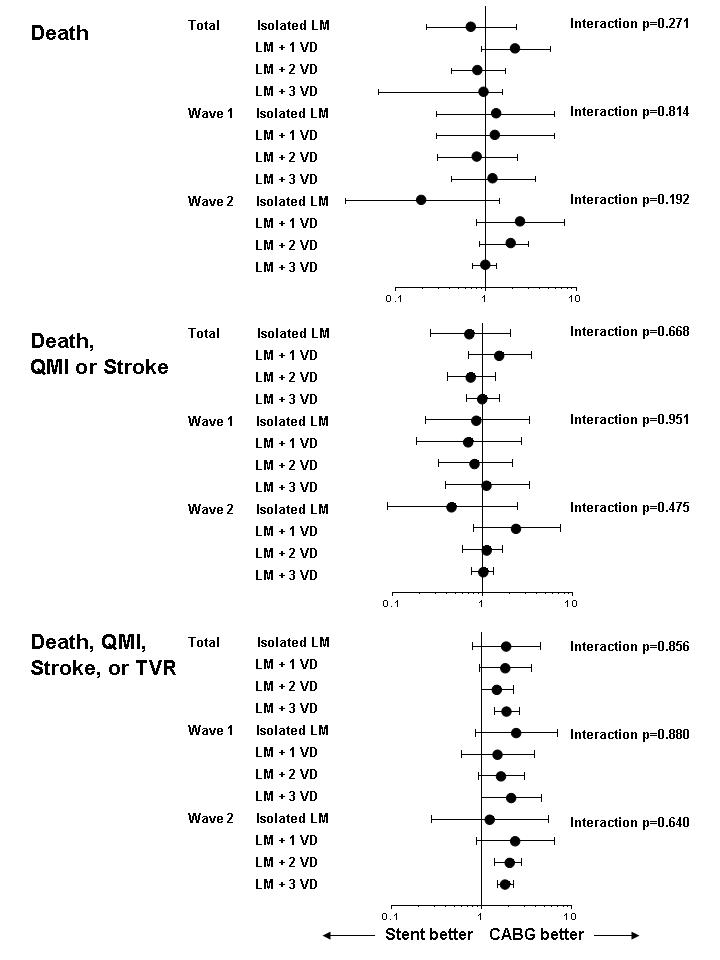| єя«•«ьљƒ : ±Єњђ
|
ЅҐЉцєш»£ - 530400 183 |
| Impact of the Extent of Vascular Disease on Outcomes after Revascularization for Unprotected Left Main Coronary Artery Stenosis |
| мЪЄмВ∞лМАнХЩкµР мДЬмЪЄмХДмВ∞л≥СмЫР |
| мХИм†ХлѓЉ, мЖ°нШЬкЈЉ, мШ§м§АнШБ, л∞ХмҐЕмД†, мµЬнШХмШ§, кєАкЄ∞нЫИ, кєАмШБнХЩ, кєАмЫРмЮ•, л∞ХлНХмЪ∞, мЭімҐЕмШБ, мЬ§мД±м≤†, к∞ХмИШмІД, мЭімКєнЩШ, мЭім≤†нЩШ, л∞ХмД±мЪ±, л∞ХмКєм†Х |
Objectives: To examine the impact of the extent of vascular disease on long-term outcomes after coronary stenting or coronary artery bypass graft (CABG) surgery for unprotected left main coronary artery (ULMCA) stenosis
Background: The differential outcome of ULMCA revascularization according to the vascular involvement remains uncertain.
Methods: From the MAIN-COMPARE registry, 2240 patients with ULMCA stenosis who underwent either stenting or CABG were stratified by number of diseased vessels.
Results: Following adjustment with EuroSCORE, stents and CABG had similar risks of death and the composite of death, Q-wave myocardial infarction (QMI) or stroke in all subgroups regardless of the number of diseased vessels over 3 years. In patients with 3-vessel disease, however, overall stent use (hazard ratio [HR], 1.913; 95% confidence interval [CI], 1.391-2.631; p<0.001) and the use of bare-metal (HR, 2.147; 95% CI, 1.002-4.600; p=0.049) and drug-eluting (HR, 1.796; 95% CI, 1.256-2.570; p=0.001) stents were associated with a higher risk of death, QMI, stroke, or target vessel revascularization (TVR) than CABG. Moreover, the HRs of death, QMI, stroke or TVR were less favorable to stenting in patients with isolated ULMCA (1.853, p=0.143) and 1-vessel (1.853, p=0.068), and 2-vessel (1.497, p=0.049) disease. Interaction of vascular involvement with type of stent or CABG was not significant.
Conclusions: Stenting appears to be a safe alternative to CABG in patients having ULMCA stenosis combined with additional vascular disease. The advantage of CABG over stenting lies principally in the reduction of repeat revascularization across subgroups stratified by the number of diseased vessels.
|
|
|
Warning: getimagesize(/home/virtual/circulationadmin/renewal/econgress/conference/abstract/img_files/ImpactofVD.jpg) [function.getimagesize]: failed to open stream: No such file or directory in /home/virtual/circulationadmin/new/econgress/conference/manage/schedule/view_abstract.php on line 164

|
|





